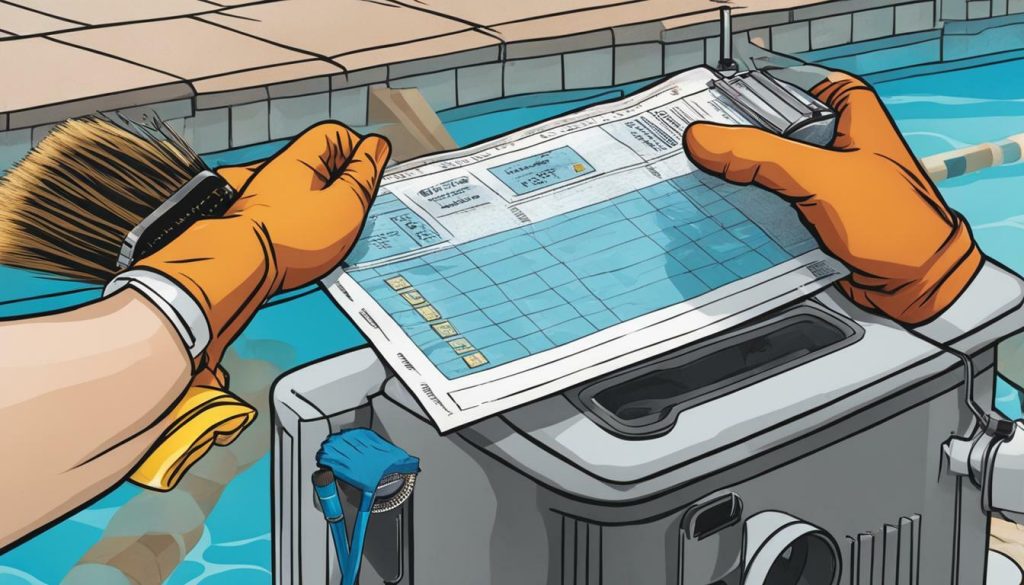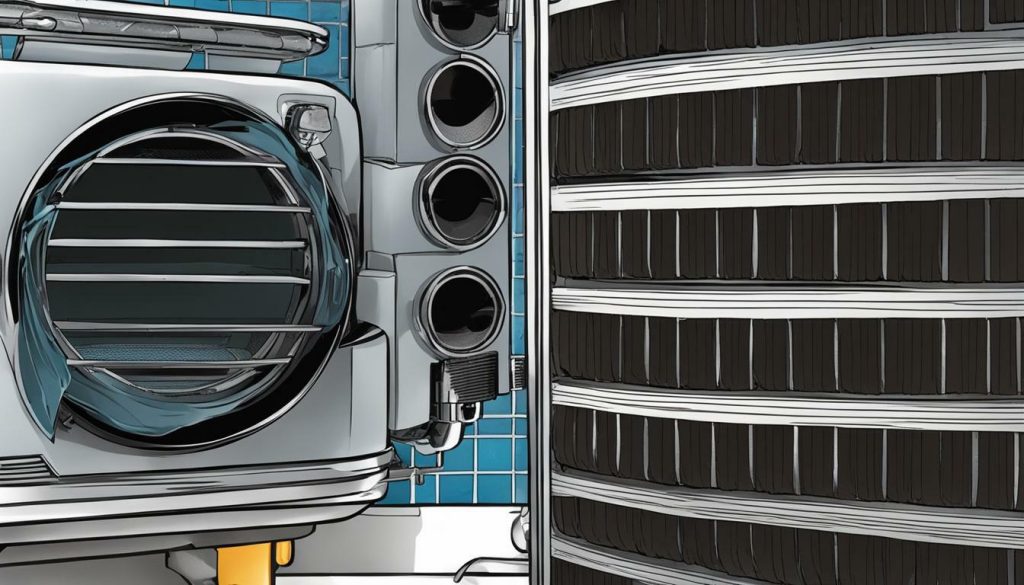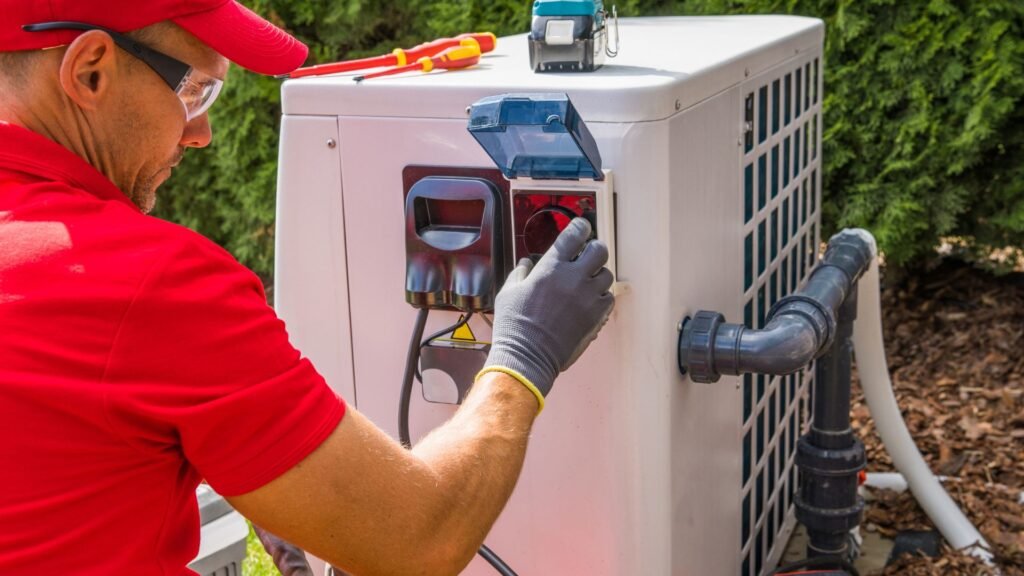Maintaining your pool heater is essential for ensuring its efficiency and longevity. Follow these pool heater maintenance tips to keep your pool ready for a swift swim all year round in South Africa.
Key Takeaways
- Regularly inspect the burner intake ports and remove debris.
- Check burners for fraying or corrosion and replace if necessary.
- Clean the pool filter regularly to maintain proper water flow.
- Keep the pool skimmer clean and unobstructed.
- Wash gas pool heater tanks to prevent clogging.
Regular Inspections and Burner Maintenance
Regularly inspecting your pool heater’s burner intake ports and burners is crucial for maintaining its efficiency and preventing potential issues. Over time, debris can accumulate in these areas, obstructing the flow of air and affecting the burner’s performance. To ensure optimal functioning, follow these maintenance tips:
- Carefully remove the burner intake ports cover and visually inspect for any debris or obstructions.
- Using a soft brush or vacuum cleaner, gently clean the intake ports to remove any dirt, leaves, or other debris that may have accumulated.
- Inspect the burners for signs of fraying or corrosion. If any damage is present, replace the burners promptly to avoid further complications.
- Check the burner flames while the heater is running. The flames should be blue and stable, indicating proper combustion. If the flames are yellow or flickering, there may be an issue with the burner that requires further investigation.
By regularly inspecting and maintaining your pool heater’s burner intake ports and burners, you can ensure that it operates efficiently and provides reliable heating for your pool.

Proper Burner Maintenance Checklist
| Steps | Description |
|---|---|
| 1 | Turn off the pool heater and disconnect the power supply. |
| 2 | Remove the burner intake ports cover. |
| 3 | Inspect the ports for any debris or obstructions. |
| 4 | Clean the intake ports using a soft brush or vacuum cleaner. |
| 5 | Check the burners for fraying or corrosion. |
| 6 | If necessary, replace damaged burners with new ones. |
| 7 | Turn on the pool heater and observe the burner flames. |
| 8 | If the flames are yellow or flickering, seek professional assistance to diagnose and fix any issues. |
Remember to always refer to your pool heater’s manufacturer guide for specific maintenance instructions and precautions. Following these guidelines will help keep your pool heater in optimal condition, ensuring efficient and reliable heating for your enjoyment.
Proper Water Flow and Filtration Maintenance
To ensure optimal performance and longevity of your pool heater, it’s important to maintain proper water flow by regularly cleaning the pool filter and keeping the skimmer clean and unobstructed. A clean and well-maintained pool filter ensures that the water circulates freely, allowing the pool heater to operate efficiently.
Start by cleaning the pool filter according to the manufacturer’s instructions. This typically involves backwashing or rinsing the filter to remove trapped debris and contaminants. A clogged or dirty filter can restrict water flow, causing strain on the pool heater and reducing its effectiveness. Regularly inspect the filter for any damage or wear and replace if necessary.
In addition to the pool filter, it’s essential to keep the pool skimmer clean and unobstructed. The skimmer removes leaves, debris, and other contaminants from the surface of the water, preventing them from clogging the filter or entering the pool heater. Clear any leaves or debris from the skimmer basket regularly and ensure that the skimmer door or flap moves freely. This will help maintain proper water flow and prevent any potential damage to the pool heater.
| Pool Heater Maintenance Tips: |
|---|
| Regularly clean the pool filter to ensure proper water flow |
| Keep the skimmer clean and unobstructed |
| Inspect the filter for damage and replace if necessary |
| Clear leaves and debris from the skimmer basket |
By following these maintenance tips and ensuring proper water flow and filtration, your pool heater will operate efficiently and provide you with warm and enjoyable swimming experiences.

Gas Pool Heater Maintenance
Gas pool heaters require specific maintenance to ensure their efficient operation. Regularly wash the tanks and check the gas supply for uninterrupted heating. It is important to keep the tanks clean to prevent clogging and ensure proper gas flow. Additionally, periodically check the gas supply to ensure there are no leaks or issues that could affect the performance of the heater.
To maintain a gas pool heater, follow these essential steps:
- Inspect the tanks and remove any debris or buildup. This will prevent clogs and ensure the heater functions optimally.
- Regularly clean the tanks with a mild detergent and water. Be sure to rinse thoroughly to remove all residues.
- Check the gas supply regularly. Look for any signs of damage, leaks, or loose connections. Address any issues promptly to prevent safety concerns and maintain efficient heating.
Remember, gas pool heaters should always be handled with caution. If you encounter any problems or are unsure about any maintenance steps, it’s best to consult a professional.
Table: Gas Pool Heater Maintenance Checklist
| Maintenance Task | Frequency |
|---|---|
| Inspect and clean the tanks | Monthly |
| Check for gas leaks or loose connections | Monthly |
| Monitor gas supply | Regularly |
Taking proper care of your gas pool heater will extend its lifespan and ensure it operates efficiently. By following these maintenance tips, you can enjoy a comfortably heated pool throughout the swimming season.

Please note that the image above is for illustrative purposes only and may not represent the exact model of your gas pool heater.
Electrical Pool Heater Maintenance
If you have an electrical pool heater, it’s important to check for mineral buildup on the heating elements and clean them regularly to optimize performance. Over time, minerals present in the pool water can accumulate on the heating elements, reducing their efficiency and potentially causing damage. To maintain your electrical pool heater, follow these steps:
- Turn off the power to the pool heater before beginning any maintenance.
- Inspect the heating elements for any signs of mineral buildup. Look for white or brown deposits on the surface.
- If you notice buildup, gently remove it using a soft brush or a non-abrasive cloth. Be careful not to scratch or damage the heating elements.
- If the mineral buildup is stubborn, you can soak the heating elements in a solution of white vinegar and water. This will help dissolve the minerals and make them easier to remove.
- After cleaning, rinse the heating elements thoroughly with clean water to remove any remaining vinegar or mineral residue.
- Once the heating elements are clean and dry, you can turn the power back on and test the pool heater to ensure it’s functioning properly.
Regular maintenance of the heating elements will not only improve the efficiency of your electrical pool heater but also extend its lifespan. By keeping the heating elements clean, you can ensure that your pool water heats up quickly and stays at the desired temperature.

Proper maintenance is essential for the longevity and efficient operation of your pool heater. By following these tips, you can keep your electrical pool heater in top condition and enjoy a warm and inviting pool throughout the year.
Additional Tips for Efficient Pool Heating
Enhance the efficiency of your pool heating system with these additional tips, such as proper installation, temperature management, and utilizing wind shelter. These strategies will help you maintain a comfortable pool temperature while minimizing energy consumption and costs.
Proper Installation
When installing your pool heater, it’s important to choose a suitable location. Place the heater on a non-combustible surface with adequate clearance around and above it. This ensures proper ventilation and prevents any potential fire hazards. Additionally, consult the manufacturer’s guidelines for the recommended installation specifications and follow them accordingly.
Temperature Management
Setting the pool heater to the lowest comfortable temperature can significantly reduce energy consumption. A few degrees lower can make a noticeable difference in your energy bills without sacrificing your swimming comfort. Invest in a high-quality thermometer to accurately monitor the pool water temperature and make adjustments as needed.
Utilizing Wind Shelter
Wind can cool down the pool water, causing heat loss and increased energy usage to maintain the desired temperature. To minimize this effect, consider creating wind shelter around your pool area. This can be achieved by installing windbreaks, such as fences, hedges, or screens, to block or redirect the wind. By reducing wind exposure, you can retain the warmth in your pool and decrease the pool heater’s workload.

By implementing these additional tips, you can optimize the efficiency of your pool heating system. Proper installation, temperature management, and utilizing wind shelter can help you maintain a comfortable swimming environment while reducing energy consumption and costs.
| Additional Tips for Efficient Pool Heating |
|---|
| Proper Installation |
| Temperature Management |
| Utilizing Wind Shelter |
Conclusion
Regular maintenance of your pool heater is essential for ensuring optimal performance and a longer lifespan. Remember to schedule regular check-ups to keep your pool heating system in top shape.
By following these instructions, you can maintain your pool heater and ensure it works efficiently for years to come. Regularly inspect the burner intake ports to remove any debris, and check the burners for fraying or corrosion. Cleaning the pool filter regularly and keeping the pool skimmer clean and unobstructed will help maintain proper water flow.
If you have a gas pool heater, be sure to wash the tanks to prevent clogging and check the gas supply regularly. For electrical pool heaters, check for mineral buildup on the heating elements and clean if necessary. It’s important to install the pool heater on a non-combustible surface with proper clearance around and above it. Installing a thermometer will help you monitor and set the pool heater to the lowest comfortable temperature.
Consider using a solar pool blanket to cover the pool when not in use and create wind shelter around the pool to reduce heat loss. You may also want to explore alternative pool heating methods such as heat pumps or solar energy pumps. And don’t forget to schedule a maintenance check-up at least once a season to ensure your pool heater is functioning properly.
FAQ
How often should I inspect the burner intake ports of my pool heater?
It is recommended to regularly inspect the burner intake ports and remove any debris to ensure proper functioning. This should be done at least once a month.
When should I replace the burners of my pool heater?
Check the burners for fraying or corrosion. If you notice any damage, it is advisable to replace them immediately to prevent further issues.
How often should I clean the pool filter?
To maintain proper water flow, it is important to clean the pool filter regularly. The frequency of cleaning may vary depending on usage, but it is recommended to clean it at least once every two weeks.
Why is it important to keep the pool skimmer clean and unobstructed?
The pool skimmer plays a crucial role in removing debris from the pool water. Keeping it clean and unobstructed ensures efficient operation and prevents clogging or damage to the pool heater.
How should I maintain a gas pool heater?
For gas pool heaters, it is essential to wash the tanks periodically to prevent clogging. Additionally, check the gas supply regularly to ensure uninterrupted operation.
How can I maintain an electrical pool heater?
Check the heating elements of the electrical pool heater for mineral buildup and clean if necessary. This will optimize the heater’s performance and extend its lifespan.
Where should I install the pool heater?
Make sure the pool heater is installed on a non-combustible surface with proper clearance around and above it. This ensures safety and proper ventilation for the heater.
What is the recommended temperature setting for the pool heater?
Install a thermometer to monitor the pool’s temperature and set the heater to the lowest comfortable level. This will save energy and prevent overheating.
How can I reduce heat loss from the pool?
Use a solar pool blanket to cover the pool when it is not in use. Additionally, creating wind shelter around the pool can minimize heat loss and improve efficiency.
Are there alternative pool heating methods I should consider?
Yes, you may want to explore alternative pool heating methods such as heat pumps or solar energy pumps. These options can be more energy-efficient and environmentally friendly.
How often should I schedule a maintenance check-up for my pool heater?
It is advisable to schedule a maintenance check-up for your pool heater at least once a season. This will ensure that it is functioning properly and identify any potential issues before they become major problems.

